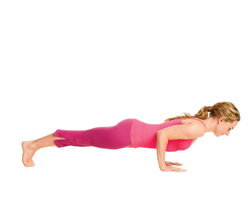A chaturanga push up is a powerful exercise. It requires an incredible amount of stabilizing muscles to hold plank alignment and then layers on movement that targets the triceps, biceps, chest and shoulder muscles. Although this exercise has amazing strengthening and toning benefits it also can cause strain on the shoulder and rotator cuff if repeatedly done improperly. Here are a few tips for a proper chaturanga, I know, sounds British :).
Start in your high plank position with the front of your shoulders aligned with the front of your wrists. Shift your weight forward so that the shoulders are forward of your fingertips, then bend your elbows. The upper arms should stay parallel with your side body – so at a full chaturanga, you would have a 90 degree bend at the elbows, with elbows stacking directly over the wrists.
A strong emphasis is needed on maintaining hand foundation. There is a tendency to roll to the pinky edge side but you want to maintain foundation on all 4 corners of the palm of your hand with fingers wide and fingertips anchored down. This foundation and the energy of drawing your hands towards one another will directly translate to better shoulder alignment and stability.
The alignment of your upper arm and the stability of your collarbones and shoulder blades is key. Focus on keeping your collar bones wide by externally rotating your upper arm bones and stabilizing your shoulder blades wide on your back with an emphasis on the outer tips drawing down your back. For your neck imagine a headrest on the ceiling and energize the back of your head towards it. RELAX YOUR JAW!
The power in your legs will also help you perfect your form and keep the load off of the shoulder joint by supporting more of your body weight. Your heels should begin over the balls of your feet but as you shift forward to lower down you will come onto your toes. Keep your legs powerful by hugging your inner thighs to the centerline, pressing your thigh bones up towards the ceiling and keeping hamstrings engaged (like you’re trying to do an isometric hamstring curl). Then focus on your pelvic stability by lifting up and engaging the base of your seat, engaging your pelvic floor and keeping your abdominal muscles corseting your spine.
I love this picture, because she shows great form and a full expression of a chaturanga – which is really HARD… and not for everyone (certainly not me many days)! Stay true to where you’re at each moment. Only bend your elbows as low as you can maintain complete stability of the rest of your body. To modify, you can bend the elbows to a lesser degree. You can also come to the knees to decrease the load even more but be cognizant of the shift forward as you lower down so that your elbows stay stacked above the wrists.
Here’s to many aligned chaturanga’s in your future!
— Jill


